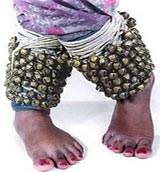GHUNGROOS
Introduction
Ghungroos are very famous Musical Instrument in India. Ghungroos are usually the small brass bells. It is a musical accessory used by performers of all classical dances. Number of bells are attached to a string or tied to a cotton cord, velvet pad or leather strap to form a ghungroo.These bells are made of brass and have small iron balls inside which add quite a lot of weight to them. When tied to the feet, Ghungroos emphasize the rhythmic aspects of the dance and allow complex footwork to be heard by the audience.
According to the Natya Sastra the Ghungroo should ideally be made of bronze or copper or silver, use of these metals makes them sweet-toned, well-shaped, and dainty, with asterisks for their presiding deities. Ghungroos are tied with indigo string - with a knot tied between each pair of bells. At the time of dancing the dancers are supposed to wear ghungroos, a hundred bells or two hundred for each foot, or a hundred for the right foot and two hundred for the left.

Ghungroos are globular bells each about 2 cm in diameter. Performers of Indian classical dances string the ghungroos on ropes or sew them onto cloth or leather strips or padded cushions and wear them around ankles. Larger ghungroos may be strung on a circle of wire and shaken as accompaniment to a song. Ghungroos are also often used or fixed with other musical instruments to add to the sound. The Ghungroo bells are often decorative items and the cords which binds them are usually bright and finished with tassels.
A Ghungroo (ghunguru) is the brass bell bracelets that kathak dancers wear wrapped around the ankles without which their dance is incomplete. Dancers typically wear between 101 and 151 bells, sometimes more, sometimes less if the dancer is very young. Unlike other classical Indian dancers who wear bells attached to leather straps, kathak dancers wear their bells strung on cord with each bell held in place by a special looped knot. The bells have iron balls inside which add quite a lot of weight, and make it necessary for the dancers to develop leg and body strength with intense training. Kathak dancers can make many different sounds with the ghungroo, making possible various intricacies of rhythm.
How to play a Ghungroo
The sounds created by the ghungroos vary in pitch depending on their metallic composition and size of the foot jewelry. Ghungroos when wore on legs serve to accentuate the rhythmic aspects of the dance and is a way to ensure that the complex footwork of the traditional dance can be heard by the audience when the dancer has her/his ghungroos tied to the feet. Ghungroos are worn right above the ankle. They rest on the lateral malleolus and medial malleolus. Again like stated earlier the number of ghungroos in the string can range anywhere from 50 to more than 200 bells woven and knotted together. A beginner or a child dancer can start with 50 of them and slowly add more as they advance in his or her technical ability. Ghungroos are worn by the traditional performances of the classical Indian dance forms like the bharatnatyam, kuchipudi, kathak and oddissi.Where to buy a Ghungroo
Contact: Mr Ashish ShrivastavaSathyadeep Musical Palace
Beside Vysya Bank
Post- Puttaparthy
Dist-- Anantapur
Andhra Pradesh Pin- 515134
INDIA
[email protected]
[email protected]
Indian Musical Instruments
2-B Netaji Subhash Marg,
Main Road,
Darya Ganj,
New Delhi 110002
India.
Helpline Number: 91-11- 43513848, 91-11- 23270666, 91-11- 23273687
Fax Number: 91 - 11 - 43582673
Email: [email protected]
Email: [email protected]
Ms. Jayshree Tarkunde
Ghungroo
29, Shivaji Nagar
Nagpur - 440 010 (Maharashtra) India
Phone(s) : +91-712-2248898/2248899
Fax : +91-712-2531040
Smt Kodhai Narayanan
Nritya Arpana
B3/7 SafdarJung Enclave
New Delhi-110029
Tele No: 011-26183484
E-mail: [email protected]


